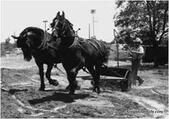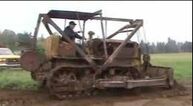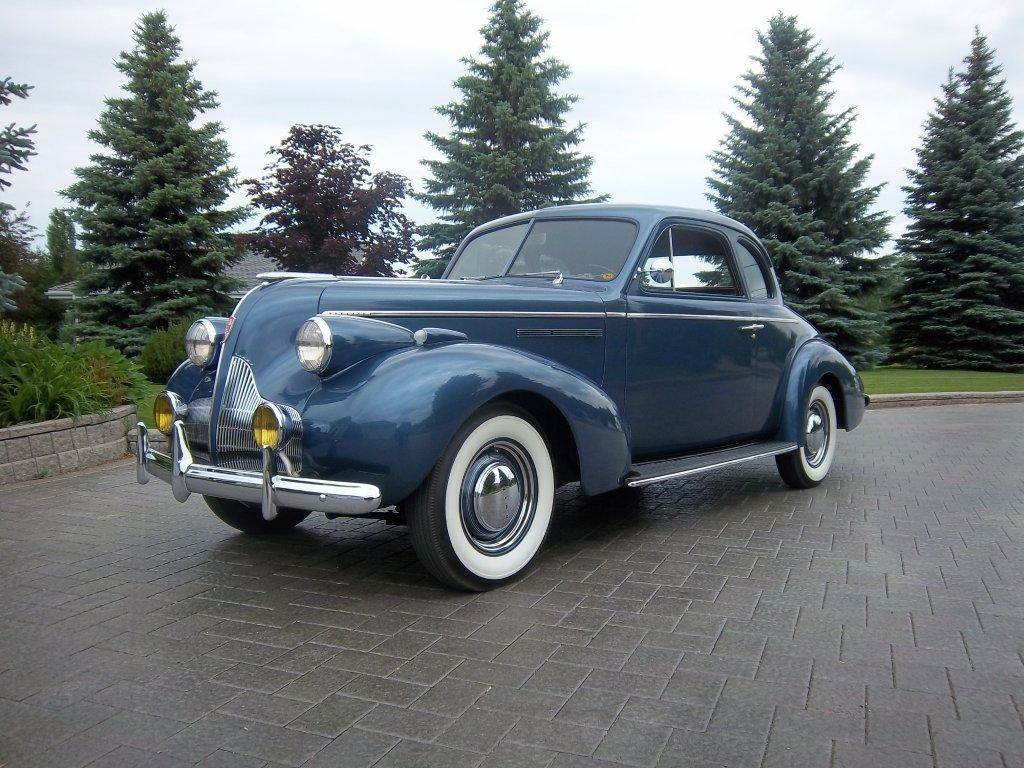|
by Ed Barthelemy Our home at 2162 Washington Street was the last house on the west side of the street, and there was only one on the east side between 19th and 22nd directly across the street from us. As I recall we paid $2,000 for the house in 1923. I was 4 years old. The street itself was never paved from 19th south, until after I left home in 1940. It ended at 22nd with a pair of ruts continuing on to the only house above 22nd on the east. From there south, from Jefferson to Lawrence, was vacant to 29th. Though at that time it wasn't called 29th; it was the Lorane Highway. The folks that graded 22nd Avenue at Lawrence Street apparently used the same transit at Washington. It was paved to the east side of Washington with a three-foot bank running north and south, leaving one lane on the north side of 22nd from which to turn right onto Washington. 22nd did not continue on to Jefferson and was absolutely impassible in the Winter. A very substantial ditch ran down the east side from 22nd to 19th. With no storm drains it was quite a waterway in a heavy rain. At all other times it presented a real driving hazard, summer or winter. Once in, there was no getting out on your own. While I suppose there were towing companies, I don't ever remember seeing one. You simply called a friend, and he hooked on and snaked you out. A couple of things that Washington Street meant to me were really not limited to that street. The first was the Newman Fish Truck, operated by the original Mr. Newman. It was a black Model-T, rigged up with what today would be called a canopy and a hanging scale. He would drop the tailgate and slice off whatever you wanted. It sounds pretty grim, but he had the fish on ice, which he shared with us little kids. I don't really know why he came only on Friday, but I suspect he had a list of good Catholics. The other was a traveling grocery store, that came—I don't remember the frequency—probably a couple times a week. It looked somewhat like an old school bus, but no windows. It was all shelves inside. I'm not sure, but I think it had solid rubber tires too. I vaguely remember him pulling up in front of the house (he always honked) and throwing one of us a block of wood to put behind the rear wheel to keep it from rolling backwards. As little kids we used to watch for him and see who got to put the block of wood he carried under the back wheel. I guess it was heavy, that just putting it in gear wouldn't hold. I guess we never wondered about the brake or the hazard involved in accomplishing that manly task. I don't know how it worked, but he had a small freezer that held a few quarts or probably pints of ice cream. But most important of all, he introduced us to frozen Milky Way bars. I even remember him inferring that they would keep us cool. Or maybe that was our own conclusion. Naturally, things were a little more expensive, but the convenience was hard to beat. It had an extremely limited selection of canned and packaged food, but it was convenient. As I think more about it, it was probably the forerunner of the 7/11. We got a sidewalk somewhere in that period around 1930, but it ended at the south side of our lot and did not run across 21st or 20th. The latter wasn't too bad, but 21st fell victim to the demon transit that was used on 22nd. With a little hand digging and laying of some planks, it was passable, though hazardous when wet. The closest bus was at 19th and Washington and ran east. Seldom used though, because it cost 5¢. 22nd Avenue When I was a kid growing up at 2162 Washington Street here in Eugene, that number (22nd) had a meaning far more meaningful than a number. Actually 22nd meant the street, which at that time ran from Washington to Willamette—no further in either east or west, unless you want to be really technical and include the block from Jefferson to Madison. That wasn't really much more than a long driveway to a house on the corner of Madison and what you could call 22nd, although there were no houses on that stretch of 22nd. It wasn't even graveled. I have no clear recollection of 22nd before it was paved, and even that mostly involved the three blocks east from Washington. In other words up to Charnelton, not because we were restricted to that area, but rather it was because so much of our free time was spent "above 22nd". Charnelton ended at 24th and dropped off into a ravine. As hard as it is for some folks to believe, it was the city dump, but that's another story. [Editor's note: That is very near where the city drinking water reservoir is today.] The intersection of 22nd and Washington, as I look back on it, was something to behold. Washington for all intents as a street ended there. A one-lane gravel driveway ran about a half-block to the lone house on the east side. To the west towards Jefferson street, there was absolutely nothing to indicate vehicular passage. Washington was blacktopped, but not the way it is done today: no curbs or gutters, and just a center stripe. Actually it was probably just oiled, with a rather deep ditch on the east side. This brings us back to 22nd. It would be interesting to study the engineering that went into the paving, not so much the pouring as the grading. The problem started at Charnelton, and the cut was so deep that it left high banks—probably ten feet—on the uphill (south) side, most noticeably between Lawrence and Washington. I'll get back to that Lawrence Street bank. At Washington the pavement ended at the original street right-of-way, which is normal, but the problem was that the grade was about five feet below the street. In other words as one would come down (westward) on 22nd, he encountered a dirt bank. As a solution the north half of 22nd was opened up by lowering the bank so one could get onto Washington. The other half remained blocked for a number of years, as I recall, probably until Washington was paved. As I mentioned above, the cut prior to paving seemed quite excessive and unnecessarily deep. Bear in mind that this was done in the Depression years, so anything that would create work was acceptable. The actual digging was done mostly with what was called a Fresno[1]. There may have been minor variations of this device, which had other names, but basically it was a horse drawn scoop operated by a man guiding direction and depth by means of two handles. It was something like a plow, but with a scoop. This was then loaded into horse-drawn wagons that opened on the bottom, like the bomb-bay doors on a bomber. If this sounds slow, it was, and while manpower was the least of the problems, getting rid of all that dirt took some head scratching. Now bear in mind that 2162 Washington (our house) was the last house on the west side. I mentioned the one house above 22nd on the east side in an earlier paragraph. There was much vacant property between us and the Lorane Highway, but for some reason, probably because it was city-owned, they decided to dump all that dirt on the lot adjoining our property on the south (between us and 22nd). It was piled up six or eight feet. There was no attempt made to flatten it either. It was all long humps just as dumped from the "bomb-bay doors", and so it remained all through my childhood. I have no recollection whatever of seeing any machinery such as a bulldozer that might have been used for grading. WPA [Editor's Note: Work Project Administration-A depression era program that aimed to put the unemployed back to work] were very common and that might possibly have been one. Otherwise it was Fresnos, horses and wagons, and men and shovels. Let's go back to Lawrence street. It ended at 22nd and while it probably deserves separate acknowledgment, I must expound on a couple of characteristics that reflected on 22nd. From 22nd to 24th was a dirt road that ran up along the west side of the reservoir without a hint of gravel. In the winter one could drive down, but not up. The reservoir also deserves a separate recognition, but for now visualize it as an open concrete box with a spiked fence around it. When constructed the excavation dirt was dropped off and more or less aligned with Lawrence. Needless to say love and feminine challenges demanded risking prized possession by driving off this cliff. I must add that access to the plateau was gained by one of three upward ramps on the east side, which got progressively steep from the southernmost to the north. All of these activities presented no problem until 22nd was put in leaving the high bank referred to earlier. More than one brave, inebriated, or femininely challenged lothario plummeted off the cliff, down Lawrence, and probably with brakes mashed to the floor found himself (too late) staring at 22nd ten feet or so below. There was not a car built that could withstand the result. Although as I recall, the young bodies did. After a couple of these incidents, a fence was constructed, but it served as nothing more than a preliminary indication of what was to come. I think the bank was eventually bladed down to offer a more gradual descent to 22nd. Naturally, the obvious hazards had the risks compounded when accomplished at night. That particular street (22nd) held no significance until I reached high school. This was in the middle 1930's, when as designed by nature it became one criterion by which we judged cars. This takes us all the way over the hill to Willamette. We found that it took a really good car to go over the top in high gear. That sounds rather simple until one bears in mind that we had to turn the corner prior to starting the ascent. As best I recall, anything less than 35 miles per hour didn't cut it. Today it is relatively easy, but one must remember that the best of those cars had 85 horse power. Lawrence Street in retrospect had some interesting sociological ramifications, especially the part from 13th south. This was not a street which I as a kid would walk alone from school at 11th and Lincoln. I could name names, but prefer not to, of the tough kids that lived on that street all the way up to 20th. I'm sure some are still alive. Eugene High was at 17th and Lincoln. Their football field ran from 19th to 20th and Lawrence to Washington. At one time it had high board tight-spaced fence all around, presumably to keep out spies from University High or Springfield High. 20th did not run through from Lawrence (nor did 21st) but some optimistic contractor dug four or five holes on the south side of 20th, which were to be basements of homes, but remained for years as just water filled holes. The soil in that area is just about the best example of gray clay to be found in the valley. Naturally the best WPA wisdom running south from 20th was selected as a terracing project for what eventually became Washington Park (Lawrence to Washington). Now if I were to leave it at that, one would have visions of earth-movers, D-8s[2] and huge dump trucks, with much noise and smoke. But not so. Not a sound. Every bit of that work was done with hand shovels and wheelbarrows. And don't forget the sticky clay. Each shovel full had to be scraped off into the wheelbarrow. What today would have been done in an afternoon actually took months and at least part of it in the rainy season. Maybe longer. To close the Lawrence Street saga, loosely speaking it ran up along the west side of the reservoir. It was more like a trail until at about 24th, it dead-ended at the north boundary of the Eugene Country Club. Back to the tough kid on Lawrence. For some strange reason it was like an island. Lincoln, Charnelton, Olive, no problem. Ditto for Washington, which was a "newer" street and was about three notches up the social ladder from any of the others. This applied mainly to the strip from 19th north, all the way to at least 8th. Much nicer houses, many professional people. Jefferson Street slid back down the social ladder. I'm not sure why, though the street car (trolley) did run on Jefferson. I can't recall where it entered north of 19th, but it did run from there (19th) to about 24th or 25th, where it turned west down to Friendly, south to 29th, east to Willamette, north to town, and so on. Now picking a few random thoughts that may have some bearing on the earlier part of this epistle. The lone house above 22nd on the east side of Washington was originally owned and built by the Miller family. He had what might be loosely referred to as a dairy. I think he owned around five cows with a little barn or shed southwest of the house and up the hill. It was beyond my comprehension that 22nd would ever be paved from Washington to the west. Even in the Summer a car might break through the clay crust into the mud. We had a cow that we "staked out" in the "pasture" between 22nd all the way to 29th, and between Washington and Jefferson. The chain was about 50 feet long, and as a stake we seemed to always have a car axle which was driven into the ground. Our mailman was Mr. Taylor. He lived on the southwest corner of 20th and Washington, and he made ninety bucks a month. Hard to imagine how impressed we were. Of course you could buy a brand new Ford for about $450, but the only ones we knew who had a new car were related to the Buick dealer. 23rd and Lincoln brings back a couple of memories, neither of which strikes me as anything short of stupid. Manholes at least in that location had cement covers about 3 inches thick, around 30 inches in diameter, and mighty heavy, but not so heavy that a group of idiots couldn't get it out of its horizontal position and roll it down Lincoln. I'm sure that thing would have gone all the way to the Butte, but it veered left at 22nd, went in one side of a house and out the other, and for whatever reason didn't do a whole lot of damage. The other incident occurred while I was in high school. My closest friend was one of those referred to earlier whose dad owned a new car, a classy midnight blue '39 Buick[3] with fender mounts. We "parked" on Lincoln north of 23rd facing north with a view of the town. When we were finished doing whatever it was we were doing (not much) my friend released the brake and we proceeded down, picking up more speed than I like to think about. All was fine until we got to about 21st. At that point we collectively discovered that this vehicle had a steering wheel lock that had not been disengaged. It could have ended in a disaster had God not put an old Nash in our way. Now when they say built like a Buick, there can be no other reason for my present existence. Can't say as much for the Nash. His dad didn't even yell at him (my friend's dad). Earlier I referred to the County Club running south from about 24th. The clubhouse as near as I can picture it was about in back of (west) of Baskin Robbins which now fronts Willamette.
Comments are closed.
|
AuthorFriendly Area Neighbors Archives
June 2021
Categories
All
|



 RSS Feed
RSS Feed